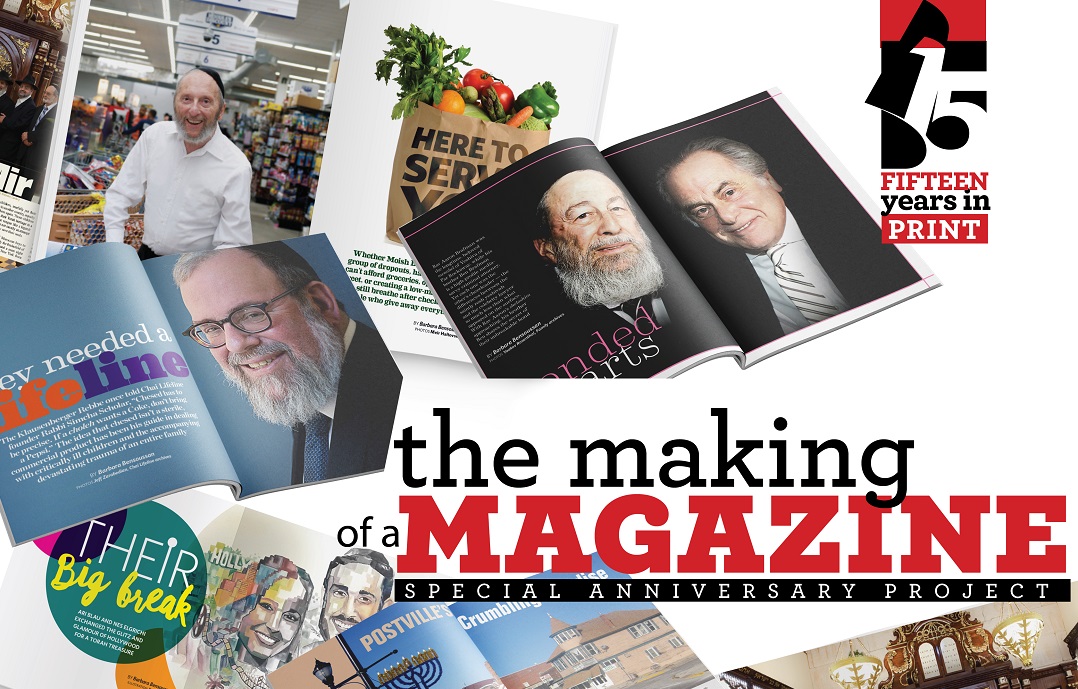Advertising Strategy
| July 8, 2020"In general, we bend over backward to make sure the reader is getting the full value he purchased the magazine for, because there is only one consideration: you, the reader"

Idon’t know how many of you remember the first time Mishpacha came out in the United States. It was truly a milestone, up there with the first Siyum HaShas in Madison Square Garden and the first kosher pizza shop. For the first time ever, we had our own full-color glossy publication that the entire family could enjoy every single week.
Until then there was the Jewish Observer, plus several short-lived magazines. There were also reliable frum newspapers. But there was no glossy weekly magazine filled with suitable reading material. Before there was Mishpacha, many people — even in very frum homes — bought Reader’s Digest. Even well-known yeshivos let their talmidim read certain publications, such as U.S. News & World Report. And of course, every businessman bought a newspaper to read during the morning train ride. Although we had no TV — and Internet and smartphones were in their infancy — we were exposed to the culture of the society around us through these publications.
Fast-forward 15 years, to today’s frum world. My children have never seen a secular magazine in their home, and we can be truly proud that this has become the norm. In fact, yesterday I related something I remembered from Reader’s Digest from years ago, and I had to explain what it was even to my married children, who had never heard of it. Everyone is busy critiquing nuances of hashkafah from our excellent writers, and rightfully so, because hashkafah is paramount. But don’t forget the influences that dominated our reading just a short time ago, and how much worse the secular media is today. That holds true for both content and advertising.
“Ad-ing” to the Vision
Mishpacha started in Israel, where it achieved widespread acceptance. While the English Mishpacha became an overnight success, here in America, there still weren’t many frum companies that could provide quality advertising in color to match the quality of the magazine. I used to look at the Hebrew issues and wonder how long it would take for American companies to develop advertising at that level of sophistication.
I got my own start in marketing and advertising at Yeshiva Sh’or Yoshuv. I had been a rebbi and menahel for many years at a high school and at the yeshivah. To help balance the budget of the yeshivah, which was started for boys who needed extra motivation, I developed Chol Hamoed Events. com, a company that did large-scale buyouts of tickets to amusement parks, concerts, and circuses. This introduced me to marketing and advertising. The main vehicle to get the word out at that time was wall posters. I once received a few hundred violations from the New York City Sanitation Department — one for each poster we hung throughout Boro Park and Flatbush.
I also helped generate publicity and set up a major outsourcing project at an Agudah convention. Eli Paley, Mishpacha’s publisher, was in the booth next to mine, introducing Mishpacha to the American Torah world, and we quickly became friends. He had a very clear vision of what he wanted in advertising — how it should complement the reading experience. Having produced ads for sophisticated campaigns, I understood what he wanted to accomplish.
The first to realize the potential and develop suitable beautiful advertising was Kedem, which signed a long-term deal. Shortly thereafter, ArtScroll became an advertiser too. I still remember my initial meeting with Rabbi Meir Zlotowitz a”h and the words he spoke. As always, he was focused on the future. He said, “I know it’s going to cut into people buying books for casual reading, if they buy such a large magazine every week, because Shabbos is really the main reading time. But you’ve created a quality publication, and I want to be a part of it.” That meeting was the beginning of a long-lasting, mutually enjoyable relationship.
Slowly companies started developing high-quality graphics in line with Eli’s vision. His genius was in creating an experience for the whole family, where the magazine is truly part of their home and their Shabbos. One of the principles Mishpacha was founded upon is that every single part of the magazine has to enhance this experience. My mandate was to be very selective and only encourage advertising that met this goal. I’m proud to say that we still uphold this goal today.
The ad-to-content ratio is constantly monitored. Promotional material is never presented as regular content to deceive the reader. In general, we bend over backward to make sure the reader is getting the full value he purchased the magazine for, because there is only one consideration: you, the reader.
Keeping It Kosher
We’ve always had a rav on staff here in the US who scrutinizes every ad. Besides the obvious things, such as making sure pictures meet our standard for tzniyus, the rav is also on the lookout for subtle and insidious influences that are destructive to our hashkafos.
Obviously, it’s very difficult to keep a balance between gashmiyus and ruchniyus in advertising. As we learn from Krias Shema, “The eye sees, then the heart covets.” This is the one function of the multibillion-dollar secular advertising industry — make people covet what they see in ads — and they are very, very good at doing it. Sometimes the message is there subliminally. Other times, it’s there openly. But secular advertising is always dictating secular society’s preferences and tastes.
Our advertising is at the front line of the battle between the physical and spiritual. We constantly strive to keep a balance between consumerism and luxury and the normal needs of our community — a balance that represents the entire spectrum of Mishpacha readers. We also have to walk a very fine line to keep the values of secular society from creeping in. Many times, we’ll send an ad back to the artist and ask him to change small details, to ensure that the ad is appropriate for a Jewish home.
Because we have a rav on staff, he can study all the content and spot the obvious issues, such as text that gives an unintended less-than-perfect impression or that cites a posek’s opinion that is unverified. Another example is when websites are included in an ad. Once a hotel for a Pesach program listed a website on their ad. When our rav checked out the website, he discovered it was linked to the hotel’s regular website, which wasn’t acceptable for frum people, and we removed the link. He opens the websites to make sure they’re suitable for Mishpacha readers.
There are also many other aspects we have to be very careful with. We carefully guard the reputations of our advertisers; for instance, we’re very strict about not including a negative reference to a competitor or anyone else, which is in keeping with the same standards that every single word in the entire magazine is checked for. Also, our rabbanim have a finely honed sense of what can cause a chillul Hashem. Many times, ads that appear elsewhere are turned away if they could create a bad impression of our way of life. Also, today the magazine is widely seen outside our community, and a turn of phrase that in our usage doesn’t mean anything could easily be misconstrued as disrespectful to other groups or to this medinah shel chesed of America.
Advice from a Sales Pro
When you’re in publishing, especially in advertising, many times things are very last minute. The artists sometimes take longer than expected to finish the details, or an ad has to go through many drafts until everyone is happy. Or details about a forthcoming event or product are waiting for confirmation. Or an ad doesn’t come in until late at night.
When Mishpacha started publishing in English 15 years ago, it was just after the Internet gave advertisers (and others) the ability to transfer large files and pictures. Before that, everything had to be physically transported, which added to the last-minute rush. For instance, when I started the Chol Hamoed project, faxes were new and were only for text. I had to use couriers to deliver graphics to the printers.
Today, we have an executive team led by Nina Feiner in the US and Hila Aftergut in Israel, which means we work almost around the clock. Our advertising team works hard to ensure that every ad is placed where it will get maximum attention. Ads that are exciting and brightly colored will look good in certain spots, while more serious ads need to be placed near a similar type of article for maximum effectiveness.
Having seen tens of thousands of ads, many times I’m in a position to give valuable advice to our clients. It’s hard for an advertiser to look at his ad through the eyes of the reader, so a big part of my job is to be the go-between and present the customer’s point of view to the company. My objective is really the same as theirs: I want the advertiser to be successful and become a long-term client.
But that means the client has to be ready for long-term success. Many times new advertisers are naive. They want to spend a lot of money up front when they’re not really ready. A company has to have a product in the stores, a sales force, a customer service department, etc., in place, before the ad runs. If the company’s website isn’t ready, for example, I tell the client to wait with advertising until it is. I do this because in the long run, my success is their success; I focus on long-term goals. Many times I have had people call me up crying that they wasted their money buying big packages of advertising elsewhere before they were ready to use it, and they thanked me for cautioning them and not pushing them to spend more than they should.
So my most important message to a new advertiser is that many components of your business have to be in place before your marketing plan will succeed. Another important rule in marketing, and in general, is not to sit and watch the competition. Focus on what you do best, especially in your advertising. The next rule, which many advertisers don’t know, is that “less is more.” Your ad will only get a few seconds of the reader’s attention, so don’t overwhelm them.
Finally, respect the reader and they will respect you. Everything in life is a relationship. People decide with their instincts if they have a good feeling about a business or organization. If you even imply negativity about your competition, it makes you look bad. But if you build a relationship based on respect, you will have a lifetime client.
With this understanding, it’s obvious that the stronger the positive feeling toward our publication, the easier it is for advertisers to win over our readers by association. In advertising they say “The medium is the message.” My role at Mishpacha magazine is to help many quality products and services become part of hundreds and hundreds of frum households.
I’LL NEVER DO SALES
When I came to work at Mishpacha 11 years ago, I had heard of the magazine — who hadn’t? — but I admit I was not a reader. At that point, the magazine was out for a few years already and pretty much on a solid footing, but on these shores at least, it was being run more like a mom-and-pop shop.
Avi Lazar, the US CEO, had been hired a few months before, in order to bring things to the next level. After evaluating the company, he noted where the holes in the process were and began to make the appropriate hires to fill those gaps — myself included. Together we developed procedures to create a seamless working experience between the US and Israel offices. While much of the work, including most graphics and production, is done in Israel, the US office handles all advertising, subscriptions, and bookkeeping.
When I was originally hired (part-time), my main role was to handle the production between the US and Israel offices.
“Oh, and by the way,” I was told, “you’ll also have to handle the marketing agencies. No big deal, just follow up with them about ads and the rest is simple… It’s not really sales.” (I had made it clear that I was not interested in sales.)
Well, that was an understatement. Over the years, the agency sales have become a huge part of the sales in general, and I’m still the only one running it. After about a year, my position grew to a full-time job, I took on my own sales besides the agencies, and last year I was promoted to US sales manager — pretty ironic for someone who said she’d never go into sales.
JUGGLING ACT
Over the years, I’ve watched the magazine grow exponentially. In this business, nothing stands still and survives. The frum community has really caught up with the times when it comes to sophisticated marketing campaigns and top-notch graphics. Most companies employ the use of a professional graphic designer — gone are the days of home-designed ads.
I’ve always taken my responsibility, to both my clients and the readers, extremely seriously; and through seminars, workshops, and accelerators, I’m always learning new ways to make the marketing process more effective for the clients and more useful for the readers. That’s the fun part — years ago we didn’t really have much more to offer a client than a basic ad. If they wanted to get creative, they would do a
teaser ad or reserve a few pages in a row. People still do those things effectively, but now we can integrate marketing into print and digital sides of the business in ways we never could before, coming up with creative packages that suit each client’s specific needs.
That said, advertising can still be a tricky business, especially when it comes to juggling the desires of potential advertisers with the needs and hashkafos of the readers. When it comes to religious sensitivity issues, I always defer to our rabbinical board, who reviews every page of the magazine — editorial as well as advertisements. Sometimes something might seem okay to me, but if the rabbis feel that people will be sensitive, our extremely seicheldig board will offer the client suggestions for success within our rabbinic guidelines.
Admittedly, we’ve turned down business that was inappropriate for our readership, but most times, having an open and honest discussion with a client about what our readership will appreciate and respond to best will result in everyone’s goals being met. And because I’ve been in this industry for so long, it’s second nature to me to know what will work and what won’t, so when a client comes in a with a grand idea (and a large budget) for something I know won’t be successful long term, I’m not going to make the sale at the expense of what’s best for the client.
The integrity of the magazine and the trust that thousands of people place in us to bring quality and appropriate material into their homes is something I constantly have in mind.
SOMETHING FOR EVERYONE
These days, a lot has changed. Now that we’re in the coronavirus era’s “new normal,” it’s pretty amazing to see how people have adapted their companies to online stores, Zoom dinners, and telehealth. Even before coronavirus, we’d shifted into helping clients in a more holistic way — working within each company’s unique parameters to find the best way to get the word out about their brand. Although the economy is uncertain, people still need to get the word out about their businesses, and I can’t tell you how many businesspeople have expressed how happy they are that Mishpacha has remained operational and dependable throughout.
(Originally featured in Mishpacha, Issue 818)
Oops! We could not locate your form.









